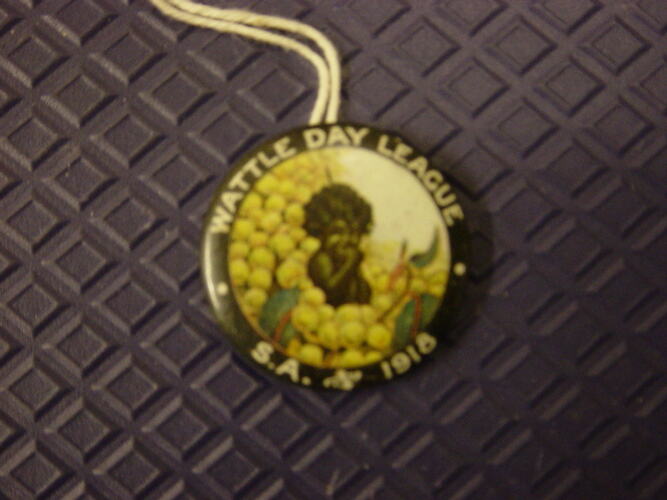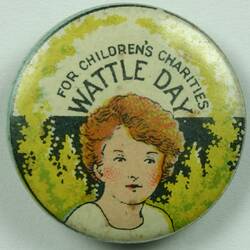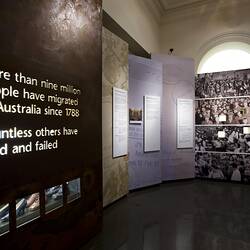Summary
Note: This object includes derogatory depictions of First Nations people. Such depictions are not condoned by Museums Victoria which considers them to be racist. Historical distance and context do not excuse or erase this fact.
Alternative Name(s): Button
Wattle Day badge made and used in South Australia in 1918. The use of an Aboriginal child surrounded by wattle as the key image on this badge is interesting as wattle and wattle day were often associated with Australian nationalist movements influenced by the idea of Australia as a 'white' and 'British' nation such as Federation, World War I fundraising and the White Australia policy.
The first 'national' Wattle Day was celebrated in Sydney, Melbourne and Adelaide on 1 September 1910. Wattle had become a symbol of Australia with the approach of Federation. It was particularly promoted by the Australian Natives' Association, established in Melbourne in 1871 as a non-partisan and non-sectarian friendly society for Australian-born, white men seeking to shape Australia's nationhood and identity. The ANA was a strong advocate for Federation and became an advocate for White Australia. It was a staunch supporter of trade protection and immigration restriction, and Prime Minister Alfred Deakin was a member. Public support for Wattle Day peaked during World War I, when it was a potent symbol of home for military personnel serving overseas, and a means of raising money for organisations such as the Red Cross. Beautifully designed Wattle Day badges as well as wattle sprigs were sold. The influence of Wattle Day waned as the 20th century progressed, but in 1992 the Governor-General declared 1 September National Wattle Day.
Physical Description
Round metal badge with dark brown border and Aboriginal child surrounded with wattle in centre. Words around border are printed in white. There is a pin at back that fits into a slot.
More Information
-
Collecting Areas
-
Acquisition Information
Transfer from Numismatics Collection, Museum of Victoria, 07 Aug 1995
-
Place & Date Made
-
Organisation Named
-
Inscriptions
Around edge, white text: 'WATTLE DAY LEAGUE. S.A. 1918 .'
-
Classification
-
Category
-
Discipline
-
Type of item
-
Overall Dimensions
3.2 cm (Length), 3.2 cm (Height)
-
Exhibition Collection Management
32 mm (Length), 32 mm (Width)
diameter
-
References
GOOD,A.M:nd. Official Record of S.A. Button Days. League of Loyal Women's Rooms. (Sands and McDougall's), Adelaide.
-
Keywords
Wars & Conflicts, Wattle Day, World War I, 1914-1918, Indigenous Peoples


